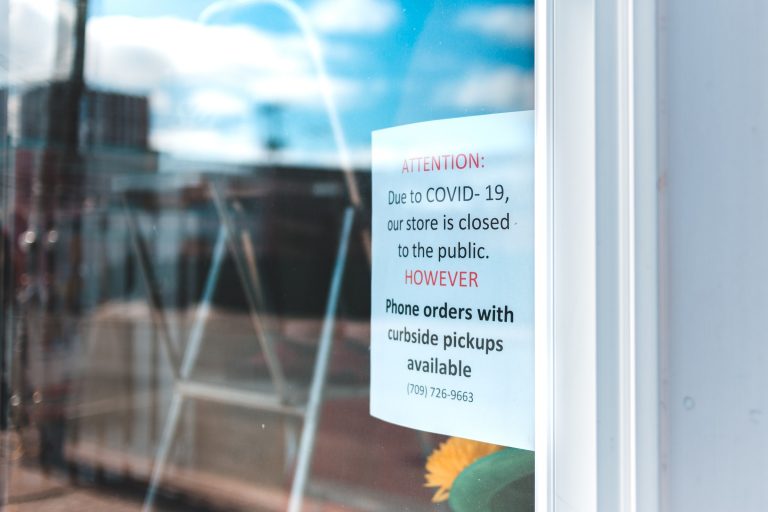We are seeing incredible stories of businesses responding to the COVID-19 restrictions and lockdowns, to simply either keep operating, keep staff employed, or to utilise their facilities to meet the unique demands that the pandemic has created. We have seen businesses respond in many ways, whether it be distilleries and breweries switching gears to produce hand sanitisers, car manufacturers using their capacity and facilities to produce ventilators and protection equipment (such as face shields and surgical masks) in addition to the usual vehicle productions, and most notably cafes, bars and restaurants shifting from in dining options to restricted takeaway menus, meal kits and produce supplies.
These activities show us the innovative strength of businesses to react positively and with community spirit in such strange and difficult times. Despite this, the economy is taking a significant hit. We know that some businesses are closing and may not re-open, even when restrictions ease and we seek to find the new normal. We are seeing substantial levels of unemployment, not to mention the severe impacts on mental health.
With this challenging setting in mind, we looked to the particularly unique tax setting arising from this pandemic with respect to the company tax loss rules. Specifically, in a recent article in The Tax Specialist, we examined the 2019 enacted similar business test (SiBT). We look at a number of pandemic induced business ‘hacks’ or ‘pivots’ around the economy to consider whether the similar business test, which is designed and enacted to capture more innovative evolutions compared to the well-established and extremely restricting same business test (SBT), could be sufficiently broad to capture these unusual innovations.
 Source: Pikist
Source: Pikist
Rules Governing Company Losses
There are well established rules surrounding the carry forward and utilisation of company losses, largely due to problematic company loss trafficking creating integrity concerns for the Australian tax system.
These begin with the continuity of ownership test, introduced in 1964, which in simple terms, looks to changes in company ownership (Subdivision 165-D Income Tax Assessment Act 1997, ITAA 1997). If failed, companies become reliant on their business activities/transactions (Subdivision 165-E ITAA 1997). This was originally in the form of the same business test, which was introduced in 1965 as a concession to the continuity of ownership test. The same business test requires an assessment of whether the same business was undertaken immediately before the continuity of ownership test was failed and the year in which the loss is being sought to apply. This test looks not only at the business, but the kind of transaction the company enters into.
The courts have been clear regarding the same business test: it is an extremely narrow test and ‘same’ means essentially exactly the same. Consequently, this can impede innovative activities by businesses. In 2019, the Australian government loosened these strict rules, with the introduction of similar business test (section 165-13 ITAA 1997). Rather than looking to assess whether activity was exactly the same, the similar business test shifts to a lower threshold of similar. This relaxation of the law offers respite to those businesses that continue to maintain their business identity but experience natural developments in their activities and operations.
Four factors are considered in assessing whether a business is similar:
(a) the extent to which the assets (including goodwill) that are used in its current business to generate assessable income throughout the business continuity test period were also used in its former business to generate assessable income;
(b) the extent to which the activities and operations from which its current business generated assessable income throughout the business continuity test period were also the activities and operations from which its former business generated assessable income;
(c) the identity of its current business and the identity of its former business;
(d) the extent to which any changes to its former business result from development or commercialisation of assets, products, processes, services or marketing or organisational methods of the former business. (section 165-211(2))
Unsurprisingly, a year after its enactment, the similar business test has not been substantively tested in the courts. With 2020 bringing with it fire, flood and now pandemic, we are now facing an environment not likely at the forefront of lawmakers minds at the time of the similar business test’s formulation and introduction. In reality, they were somewhat close to the mark: the same business test was seen to impede innovative business activity and start-ups and flexibility for innovative business practice is what COVID-19 has spurred along. However, has business responsiveness under COVID-19 stretched the similar business test beyond its scope?
COVID-19 Business Hacks and the similar business test
We look to hypothetical business hacks to determine their likelihood of meeting or breaching the similar business test, on the assumption that the continuity of ownership is failed, and find that in some instances the similar business test is likely failed, whilst in others it may continue to be met. Specifically, we look at the following three business scenarios based on examples of actual economic activity occurring in response to COVID-19:
- A distillery closes its doors and turns to manufacturing hand sanitiser;
- A car manufacturer expands its operations to manufacture not only cars, but ventilators and protective equipment; and,
- A restaurant closes its doors to dining in customers and instead shifts its operations to takeaway, delivery and food kits (see Morton & Hinchliffe, 2020, p. 218).
In doing so, we examine the legislation surrounding the similar business test, explanatory documentation (explanatory memorandum to the Treasury Laws Amendment (2017 Enterprise Incentives No. 1) Bill 2019 (Cth)), the law companion ruling (LCR 2019/1 The business continuity test – carrying on a similar business), and relevant private binding rulings.
Our analysis shows that dramatic shifts in activities during COVID-19, particularly where core business activities cease, would likely lead to failing the similar business test, whereas ancillary or supplementary activities would not necessarily cause an issue with the test. In reaching this conclusion, we interpret these circumstances as comparable to start-up businesses pivoting,
in effect, the COVID-19 environment may create situations in which established businesses will, in essence, reflect the nature and characteristics of start-ups, by undertaking major pivots. This analysis therefore challenges the ability of SiBT to overcome the potential loss of tax losses arising from (necessary) innovations that respond to COVID-19 restrictions and crises (Morton & Hinchliffe, 2020, p. 220).
We note that due to the dynamic nature of the pandemic, there are likely to be numerous examples of pivoting in business, as the community faces rounds of lockdowns. For example, we have already seen in Victoria, the second round of stage 4 lockdowns. This could create challenges in managing the tax affairs of many companies and we highlight the need for strong record keeping in line with prior research on smaller/start-up companies.
A need to recognise COVID-19 business pivots
We have all seen and heard of the various innovations that businesses are carrying out in response to closures and restrictions due to the COVID-19 pandemic. These must be applauded, as we see communities working together to support those particularly impacted and to assist in the provision of key products and services for health workers to do their jobs. As usual, it is often regulation that is troublesome in keeping up with such entrepreneurial activities (and technology) and we must be alert to the unusual circumstances in 2020 and how this may interact with the tax law.
As with many other areas of tax compliance in 2020, the Government could consider offering targeted relief to company taxpayers that would lose access to their tax losses due to genuine COVID-19 specific business pivots. Given that these taxpayers would need to fail the continuity of ownership test first, this will likely impact a very specific category of companies.
Furthermore, we highlight that, irrespective of whether or not targeted relief is offered, tax practitioners as well as the Commissioner, will need to be particularly alert to pivot activity around this time and pay close attention to company records, as for example business pivots could be misconstrued with avoidance activities and the timing of pivots can become particularly relevant.





Recent Comments